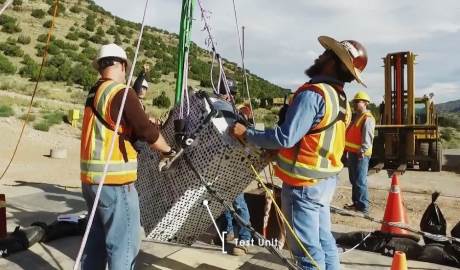Holtec International has successfully completed a series of free drop-tests on its HI-STAR ATB-1T waste cask. The cask has a rectangular footprint, unlike cylindrical fuel-bearing transport casks.
 |
| Setting up for the centre-of-gravity-over-corner drop test (Image: Holtec) |
The HI-STAR ATB 1T - also known as the HI-STAR 330 - is designed for transportation of radioactive non-fuel waste and hardware from reactor operations and decommissioning. Holtec submitted its safety analysis report for US Nuclear Regulatory Commission (NRC) approval in October 2015, planning to start production in 2017 subject to the successful completion of the licence certification process.
To earn certification, a transport cask must pass a series of "free drop" tests in which a scaled replica of the loaded cask is dropped from a height of 30 feet (9 metres) on to an unyielding surface. The cask's ability to maintain its radiation-blocking capability must remain substantially unimpaired. Both US and international regulations require the cask's orientation at impact with the target surface to be selected so as to induce the maximum damage to the cask.
A quarter-scale model of the ATB-1T cask, fabricated by Holtec's manufacturing division and instrumented by the Sandia National Laboratory of New Mexico, was subjected to three successive drops in three discrete orientations in accordance with the a plan reviewed by the NRC. The tests were carried out at Sandia National Laboratories' Albequerque drop test facility. The direct collisions included a top down oblique drop, a centre-of-gravity-over-corner drop, and a puncture drop test. The cask met the structural sufficiency criteria and sustained no damage to its containment boundary or dislodging of its closure lid, Holtec said.
According to Holtec’s design team, the cask exhibited physical deformation contours in line with those predicted by computer simulations. The data collected during the tests will now be processed and is expected to confirm the successful structural performance of the cask under the qualifying accidental drop scenarios. The computer simulations will also provide a valuable benchmark for the computer code, validated under Holtec’s quality assurance program, routinely used to simulate impact phenomena in a variety of nuclear plant systems, structures, and components.
While fuel-bearing transport casks are cylindrical, the ATB-1T cask has a large rectangular footprint (about 12 feet by 5.9 feet, or 3.7 metres by 1.8 metres) with several corners, facets and edges that render it vulnerable to a crushing impact loading. The ATB-1T cask, which with its payload weighs over 120 tonnes, has no impact limiter to cushion its impact upon its collision with the target, unlike cylindrical casks which are fitted with impact limiters. Avoiding the need for impact limiters simplifies operations and reduces operational dose associated with impact limiter installation, Holtec says.
The ATB-1T cask is also equipped with an innovative quick connect/disconnect controlled cask locking system rather than a conventional bolted lid.
Researched and written
by World Nuclear News




_82983.jpg)
_34792.jpg)
_16403_79272.jpg)
_44458.jpg)

_76087_55556.jpg)



